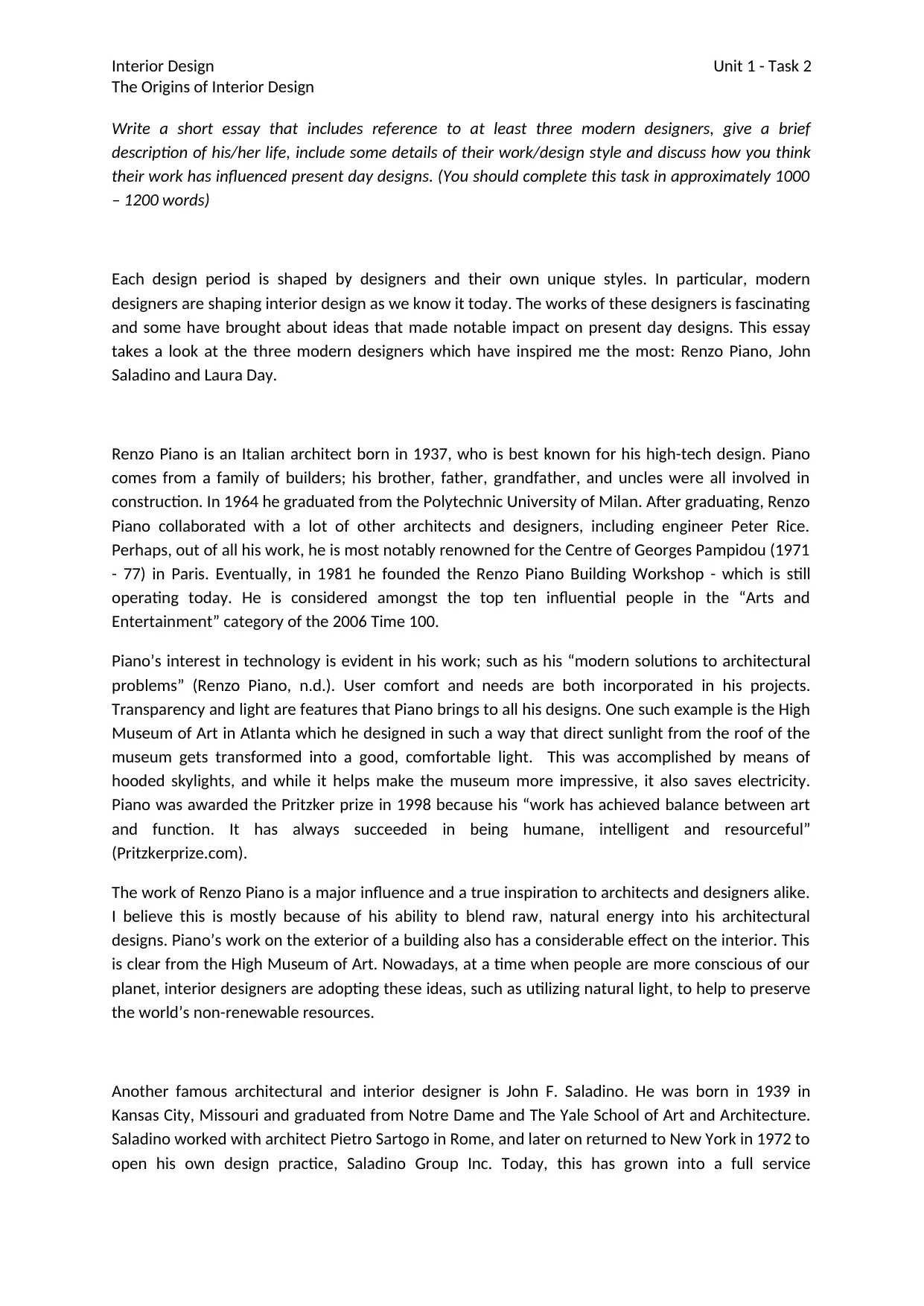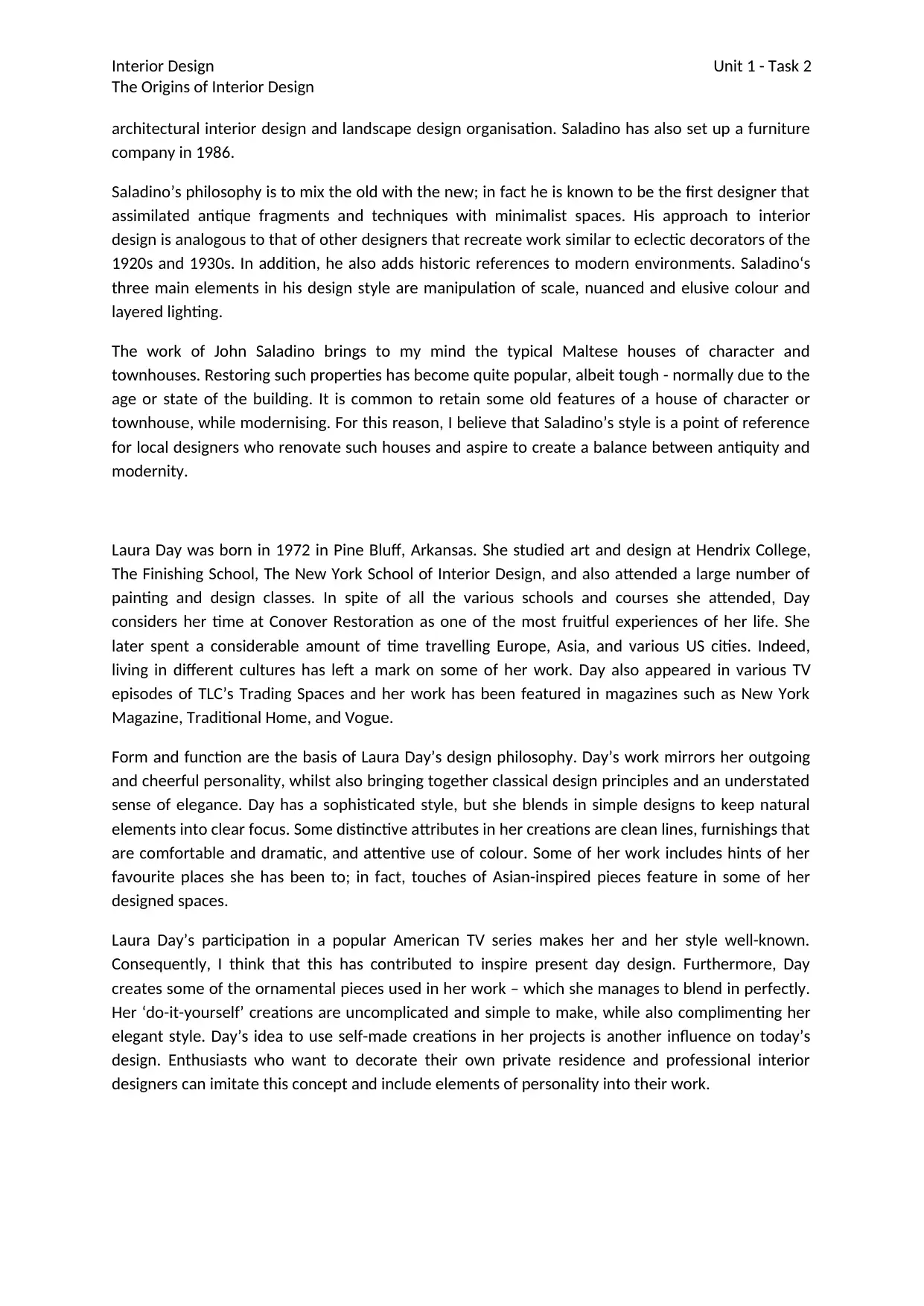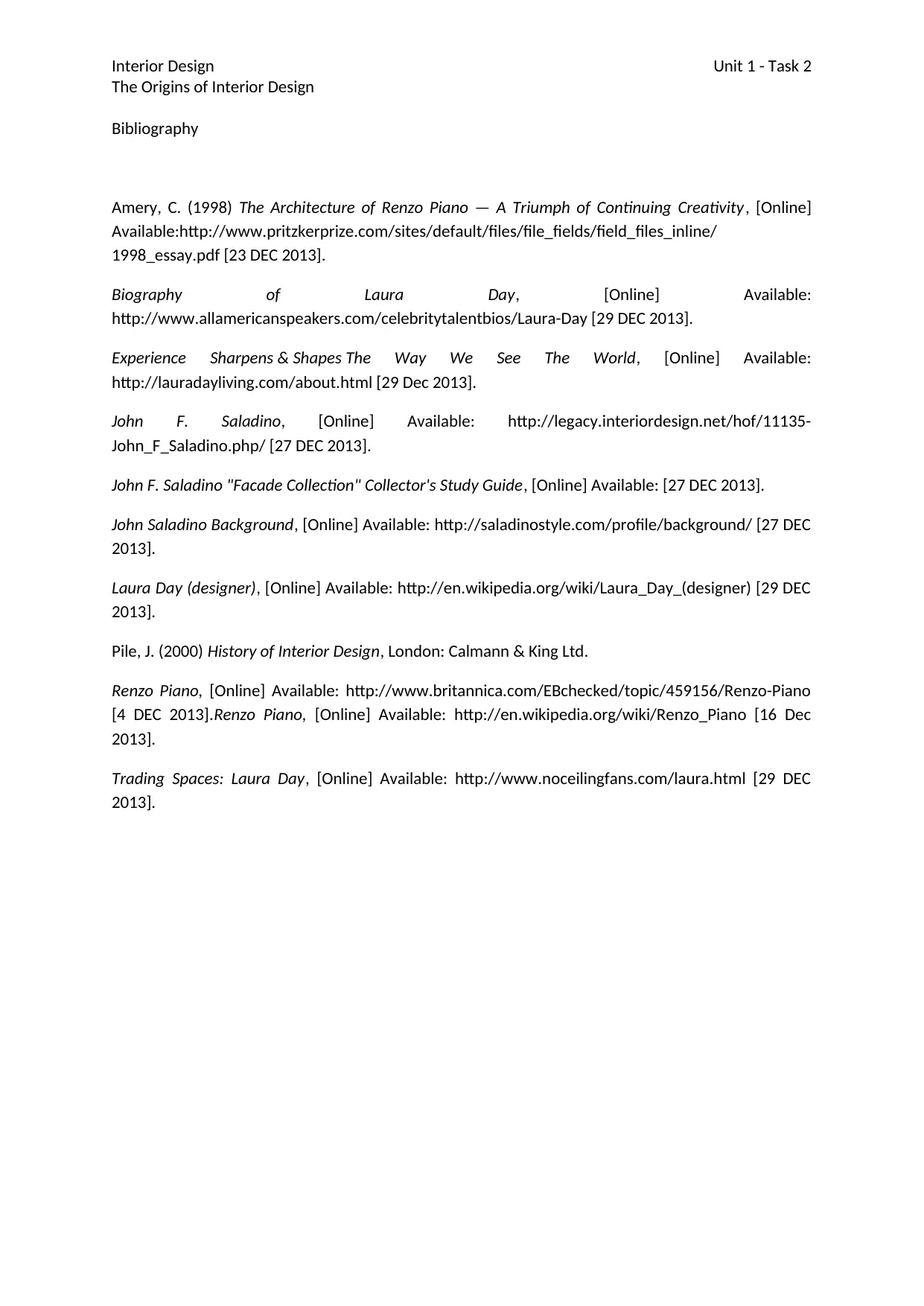Interior Design: The Origins and Influence of Modern Designers
VerifiedAdded on 2022/01/19
|4
|1501
|245
Essay
AI Summary
This essay delves into the contributions of three influential modern designers: Renzo Piano, John Saladino, and Laura Day. It begins by examining Renzo Piano's high-tech design approach, his focus on user comfort, and his ability to integrate natural light, exemplified by the High Museum of Art. The essay then explores John Saladino's design philosophy, which blends old and new elements, referencing his use of antique fragments and minimalist spaces, and how his style influences modern renovations. Finally, it analyzes Laura Day's design principles, emphasizing form and function, her use of clean lines, and her incorporation of self-made decorative pieces, highlighting her impact through her television appearances. The essay concludes by emphasizing the lasting influence of these designers on contemporary interior design, particularly in their innovative use of light, historical references, and personalized design elements.

Interior Design Unit 1 - Task 2
The Origins of Interior Design
Write a short essay that includes reference to at least three modern designers, give a brief
description of his/her life, include some details of their work/design style and discuss how you think
their work has influenced present day designs. (You should complete this task in approximately 1000
– 1200 words)
Each design period is shaped by designers and their own unique styles. In particular, modern
designers are shaping interior design as we know it today. The works of these designers is fascinating
and some have brought about ideas that made notable impact on present day designs. This essay
takes a look at the three modern designers which have inspired me the most: Renzo Piano, John
Saladino and Laura Day.
Renzo Piano is an Italian architect born in 1937, who is best known for his high-tech design. Piano
comes from a family of builders; his brother, father, grandfather, and uncles were all involved in
construction. In 1964 he graduated from the Polytechnic University of Milan. After graduating, Renzo
Piano collaborated with a lot of other architects and designers, including engineer Peter Rice.
Perhaps, out of all his work, he is most notably renowned for the Centre of Georges Pampidou (1971
- 77) in Paris. Eventually, in 1981 he founded the Renzo Piano Building Workshop - which is still
operating today. He is considered amongst the top ten influential people in the “Arts and
Entertainment” category of the 2006 Time 100.
Piano’s interest in technology is evident in his work; such as his “modern solutions to architectural
problems” (Renzo Piano, n.d.). User comfort and needs are both incorporated in his projects.
Transparency and light are features that Piano brings to all his designs. One such example is the High
Museum of Art in Atlanta which he designed in such a way that direct sunlight from the roof of the
museum gets transformed into a good, comfortable light. This was accomplished by means of
hooded skylights, and while it helps make the museum more impressive, it also saves electricity.
Piano was awarded the Pritzker prize in 1998 because his “work has achieved balance between art
and function. It has always succeeded in being humane, intelligent and resourceful”
(Pritzkerprize.com).
The work of Renzo Piano is a major influence and a true inspiration to architects and designers alike.
I believe this is mostly because of his ability to blend raw, natural energy into his architectural
designs. Piano’s work on the exterior of a building also has a considerable effect on the interior. This
is clear from the High Museum of Art. Nowadays, at a time when people are more conscious of our
planet, interior designers are adopting these ideas, such as utilizing natural light, to help to preserve
the world’s non-renewable resources.
Another famous architectural and interior designer is John F. Saladino. He was born in 1939 in
Kansas City, Missouri and graduated from Notre Dame and The Yale School of Art and Architecture.
Saladino worked with architect Pietro Sartogo in Rome, and later on returned to New York in 1972 to
open his own design practice, Saladino Group Inc. Today, this has grown into a full service
The Origins of Interior Design
Write a short essay that includes reference to at least three modern designers, give a brief
description of his/her life, include some details of their work/design style and discuss how you think
their work has influenced present day designs. (You should complete this task in approximately 1000
– 1200 words)
Each design period is shaped by designers and their own unique styles. In particular, modern
designers are shaping interior design as we know it today. The works of these designers is fascinating
and some have brought about ideas that made notable impact on present day designs. This essay
takes a look at the three modern designers which have inspired me the most: Renzo Piano, John
Saladino and Laura Day.
Renzo Piano is an Italian architect born in 1937, who is best known for his high-tech design. Piano
comes from a family of builders; his brother, father, grandfather, and uncles were all involved in
construction. In 1964 he graduated from the Polytechnic University of Milan. After graduating, Renzo
Piano collaborated with a lot of other architects and designers, including engineer Peter Rice.
Perhaps, out of all his work, he is most notably renowned for the Centre of Georges Pampidou (1971
- 77) in Paris. Eventually, in 1981 he founded the Renzo Piano Building Workshop - which is still
operating today. He is considered amongst the top ten influential people in the “Arts and
Entertainment” category of the 2006 Time 100.
Piano’s interest in technology is evident in his work; such as his “modern solutions to architectural
problems” (Renzo Piano, n.d.). User comfort and needs are both incorporated in his projects.
Transparency and light are features that Piano brings to all his designs. One such example is the High
Museum of Art in Atlanta which he designed in such a way that direct sunlight from the roof of the
museum gets transformed into a good, comfortable light. This was accomplished by means of
hooded skylights, and while it helps make the museum more impressive, it also saves electricity.
Piano was awarded the Pritzker prize in 1998 because his “work has achieved balance between art
and function. It has always succeeded in being humane, intelligent and resourceful”
(Pritzkerprize.com).
The work of Renzo Piano is a major influence and a true inspiration to architects and designers alike.
I believe this is mostly because of his ability to blend raw, natural energy into his architectural
designs. Piano’s work on the exterior of a building also has a considerable effect on the interior. This
is clear from the High Museum of Art. Nowadays, at a time when people are more conscious of our
planet, interior designers are adopting these ideas, such as utilizing natural light, to help to preserve
the world’s non-renewable resources.
Another famous architectural and interior designer is John F. Saladino. He was born in 1939 in
Kansas City, Missouri and graduated from Notre Dame and The Yale School of Art and Architecture.
Saladino worked with architect Pietro Sartogo in Rome, and later on returned to New York in 1972 to
open his own design practice, Saladino Group Inc. Today, this has grown into a full service
Paraphrase This Document
Need a fresh take? Get an instant paraphrase of this document with our AI Paraphraser

Interior Design Unit 1 - Task 2
The Origins of Interior Design
architectural interior design and landscape design organisation. Saladino has also set up a furniture
company in 1986.
Saladino’s philosophy is to mix the old with the new; in fact he is known to be the first designer that
assimilated antique fragments and techniques with minimalist spaces. His approach to interior
design is analogous to that of other designers that recreate work similar to eclectic decorators of the
1920s and 1930s. In addition, he also adds historic references to modern environments. Saladino‘s
three main elements in his design style are manipulation of scale, nuanced and elusive colour and
layered lighting.
The work of John Saladino brings to my mind the typical Maltese houses of character and
townhouses. Restoring such properties has become quite popular, albeit tough - normally due to the
age or state of the building. It is common to retain some old features of a house of character or
townhouse, while modernising. For this reason, I believe that Saladino’s style is a point of reference
for local designers who renovate such houses and aspire to create a balance between antiquity and
modernity.
Laura Day was born in 1972 in Pine Bluff, Arkansas. She studied art and design at Hendrix College,
The Finishing School, The New York School of Interior Design, and also attended a large number of
painting and design classes. In spite of all the various schools and courses she attended, Day
considers her time at Conover Restoration as one of the most fruitful experiences of her life. She
later spent a considerable amount of time travelling Europe, Asia, and various US cities. Indeed,
living in different cultures has left a mark on some of her work. Day also appeared in various TV
episodes of TLC’s Trading Spaces and her work has been featured in magazines such as New York
Magazine, Traditional Home, and Vogue.
Form and function are the basis of Laura Day’s design philosophy. Day’s work mirrors her outgoing
and cheerful personality, whilst also bringing together classical design principles and an understated
sense of elegance. Day has a sophisticated style, but she blends in simple designs to keep natural
elements into clear focus. Some distinctive attributes in her creations are clean lines, furnishings that
are comfortable and dramatic, and attentive use of colour. Some of her work includes hints of her
favourite places she has been to; in fact, touches of Asian-inspired pieces feature in some of her
designed spaces.
Laura Day’s participation in a popular American TV series makes her and her style well-known.
Consequently, I think that this has contributed to inspire present day design. Furthermore, Day
creates some of the ornamental pieces used in her work – which she manages to blend in perfectly.
Her ‘do-it-yourself’ creations are uncomplicated and simple to make, while also complimenting her
elegant style. Day’s idea to use self-made creations in her projects is another influence on today’s
design. Enthusiasts who want to decorate their own private residence and professional interior
designers can imitate this concept and include elements of personality into their work.
The Origins of Interior Design
architectural interior design and landscape design organisation. Saladino has also set up a furniture
company in 1986.
Saladino’s philosophy is to mix the old with the new; in fact he is known to be the first designer that
assimilated antique fragments and techniques with minimalist spaces. His approach to interior
design is analogous to that of other designers that recreate work similar to eclectic decorators of the
1920s and 1930s. In addition, he also adds historic references to modern environments. Saladino‘s
three main elements in his design style are manipulation of scale, nuanced and elusive colour and
layered lighting.
The work of John Saladino brings to my mind the typical Maltese houses of character and
townhouses. Restoring such properties has become quite popular, albeit tough - normally due to the
age or state of the building. It is common to retain some old features of a house of character or
townhouse, while modernising. For this reason, I believe that Saladino’s style is a point of reference
for local designers who renovate such houses and aspire to create a balance between antiquity and
modernity.
Laura Day was born in 1972 in Pine Bluff, Arkansas. She studied art and design at Hendrix College,
The Finishing School, The New York School of Interior Design, and also attended a large number of
painting and design classes. In spite of all the various schools and courses she attended, Day
considers her time at Conover Restoration as one of the most fruitful experiences of her life. She
later spent a considerable amount of time travelling Europe, Asia, and various US cities. Indeed,
living in different cultures has left a mark on some of her work. Day also appeared in various TV
episodes of TLC’s Trading Spaces and her work has been featured in magazines such as New York
Magazine, Traditional Home, and Vogue.
Form and function are the basis of Laura Day’s design philosophy. Day’s work mirrors her outgoing
and cheerful personality, whilst also bringing together classical design principles and an understated
sense of elegance. Day has a sophisticated style, but she blends in simple designs to keep natural
elements into clear focus. Some distinctive attributes in her creations are clean lines, furnishings that
are comfortable and dramatic, and attentive use of colour. Some of her work includes hints of her
favourite places she has been to; in fact, touches of Asian-inspired pieces feature in some of her
designed spaces.
Laura Day’s participation in a popular American TV series makes her and her style well-known.
Consequently, I think that this has contributed to inspire present day design. Furthermore, Day
creates some of the ornamental pieces used in her work – which she manages to blend in perfectly.
Her ‘do-it-yourself’ creations are uncomplicated and simple to make, while also complimenting her
elegant style. Day’s idea to use self-made creations in her projects is another influence on today’s
design. Enthusiasts who want to decorate their own private residence and professional interior
designers can imitate this concept and include elements of personality into their work.

Interior Design Unit 1 - Task 2
The Origins of Interior Design
Renzo Piano, John Saladino and Laura Day have all managed to bring about their own distinctive
ideas into modern design. On taking a look at their work, one can’t help but get awed by what they
have accomplished so far. They have contributed immensely to modern design and are sources of
influence for other designers. I also believe that their influences will last and they will continue to be
an inspiration in the future.
The Origins of Interior Design
Renzo Piano, John Saladino and Laura Day have all managed to bring about their own distinctive
ideas into modern design. On taking a look at their work, one can’t help but get awed by what they
have accomplished so far. They have contributed immensely to modern design and are sources of
influence for other designers. I also believe that their influences will last and they will continue to be
an inspiration in the future.
⊘ This is a preview!⊘
Do you want full access?
Subscribe today to unlock all pages.

Trusted by 1+ million students worldwide

Interior Design Unit 1 - Task 2
The Origins of Interior Design
Bibliography
Amery, C. (1998) The Architecture of Renzo Piano — A Triumph of Continuing Creativity, [Online]
Available:http://www.pritzkerprize.com/sites/default/files/file_fields/field_files_inline/
1998_essay.pdf [23 DEC 2013].
Biography of Laura Day, [Online] Available:
http://www.allamericanspeakers.com/celebritytalentbios/Laura-Day [29 DEC 2013].
Experience Sharpens & Shapes The Way We See The World, [Online] Available:
http://lauradayliving.com/about.html [29 Dec 2013].
John F. Saladino, [Online] Available: http://legacy.interiordesign.net/hof/11135-
John_F_Saladino.php/ [27 DEC 2013].
John F. Saladino "Facade Collection" Collector's Study Guide, [Online] Available: [27 DEC 2013].
John Saladino Background, [Online] Available: http://saladinostyle.com/profile/background/ [27 DEC
2013].
Laura Day (designer), [Online] Available: http://en.wikipedia.org/wiki/Laura_Day_(designer) [29 DEC
2013].
Pile, J. (2000) History of Interior Design, London: Calmann & King Ltd.
Renzo Piano, [Online] Available: http://www.britannica.com/EBchecked/topic/459156/Renzo-Piano
[4 DEC 2013].Renzo Piano, [Online] Available: http://en.wikipedia.org/wiki/Renzo_Piano [16 Dec
2013].
Trading Spaces: Laura Day, [Online] Available: http://www.noceilingfans.com/laura.html [29 DEC
2013].
The Origins of Interior Design
Bibliography
Amery, C. (1998) The Architecture of Renzo Piano — A Triumph of Continuing Creativity, [Online]
Available:http://www.pritzkerprize.com/sites/default/files/file_fields/field_files_inline/
1998_essay.pdf [23 DEC 2013].
Biography of Laura Day, [Online] Available:
http://www.allamericanspeakers.com/celebritytalentbios/Laura-Day [29 DEC 2013].
Experience Sharpens & Shapes The Way We See The World, [Online] Available:
http://lauradayliving.com/about.html [29 Dec 2013].
John F. Saladino, [Online] Available: http://legacy.interiordesign.net/hof/11135-
John_F_Saladino.php/ [27 DEC 2013].
John F. Saladino "Facade Collection" Collector's Study Guide, [Online] Available: [27 DEC 2013].
John Saladino Background, [Online] Available: http://saladinostyle.com/profile/background/ [27 DEC
2013].
Laura Day (designer), [Online] Available: http://en.wikipedia.org/wiki/Laura_Day_(designer) [29 DEC
2013].
Pile, J. (2000) History of Interior Design, London: Calmann & King Ltd.
Renzo Piano, [Online] Available: http://www.britannica.com/EBchecked/topic/459156/Renzo-Piano
[4 DEC 2013].Renzo Piano, [Online] Available: http://en.wikipedia.org/wiki/Renzo_Piano [16 Dec
2013].
Trading Spaces: Laura Day, [Online] Available: http://www.noceilingfans.com/laura.html [29 DEC
2013].
1 out of 4
Related Documents
Your All-in-One AI-Powered Toolkit for Academic Success.
+13062052269
info@desklib.com
Available 24*7 on WhatsApp / Email
![[object Object]](/_next/static/media/star-bottom.7253800d.svg)
Unlock your academic potential
Copyright © 2020–2025 A2Z Services. All Rights Reserved. Developed and managed by ZUCOL.




